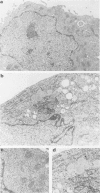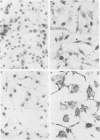Abstract
The effect of sodium butyrate on mouse and human melanoma cell lines was evaluated. Sodium butyrate (0.1-2mM) is shown to reduce the clonogenic potential of several melanoma cell lines. The antiproliferative effect of sodium butyrate is accompanied by a marked increase in the activity of the plasma-membrane bound enzyme gamma-glutamyl transpeptidase. Sodium butyrate treated cells acquire a well developed rough endoplasmic reticulum and accumulate fat droplets. The development of the endoplasmic reticulum is associated with a marked increase in the activity of the enzyme marker NADPH cytochrome c reductase. It is suggested that the phenotypic alterations induced by sodium butyrate may serve as markers for the action of this agent on melanoma cells and other tumours.
Full text
PDF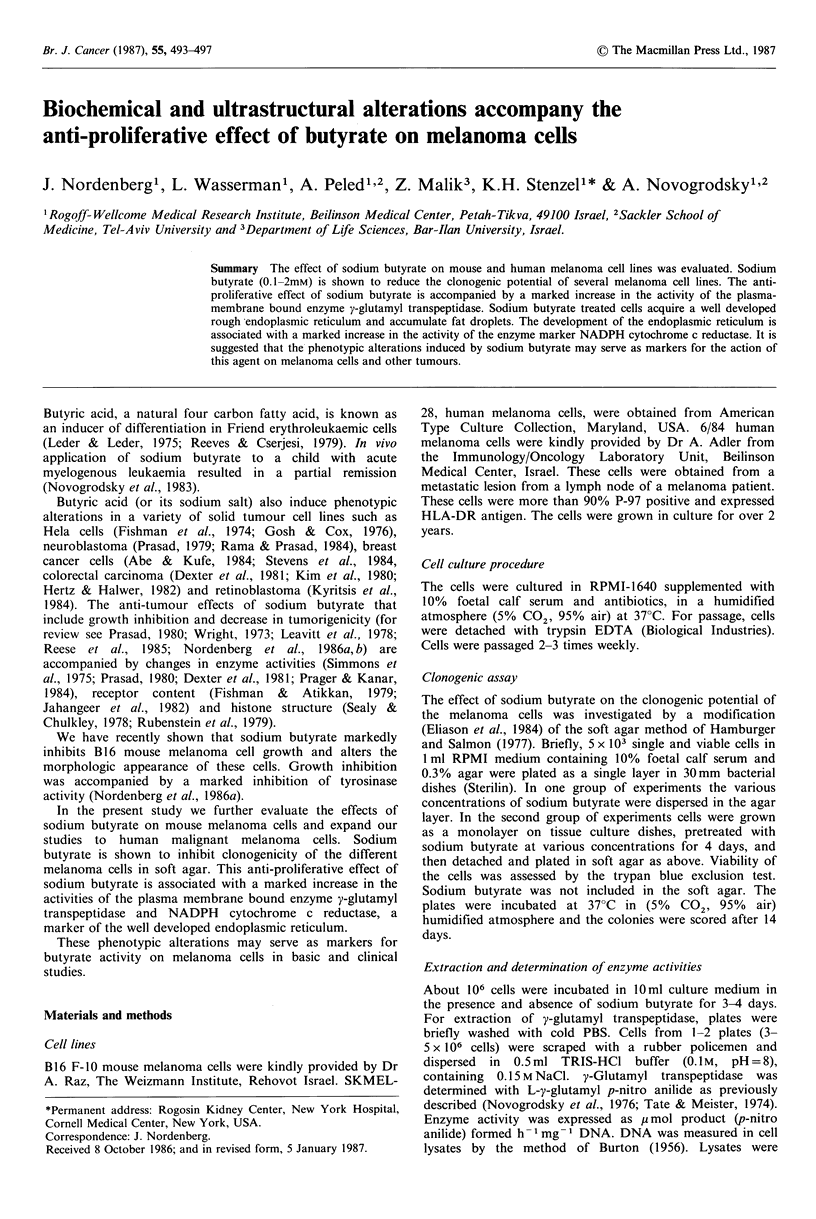
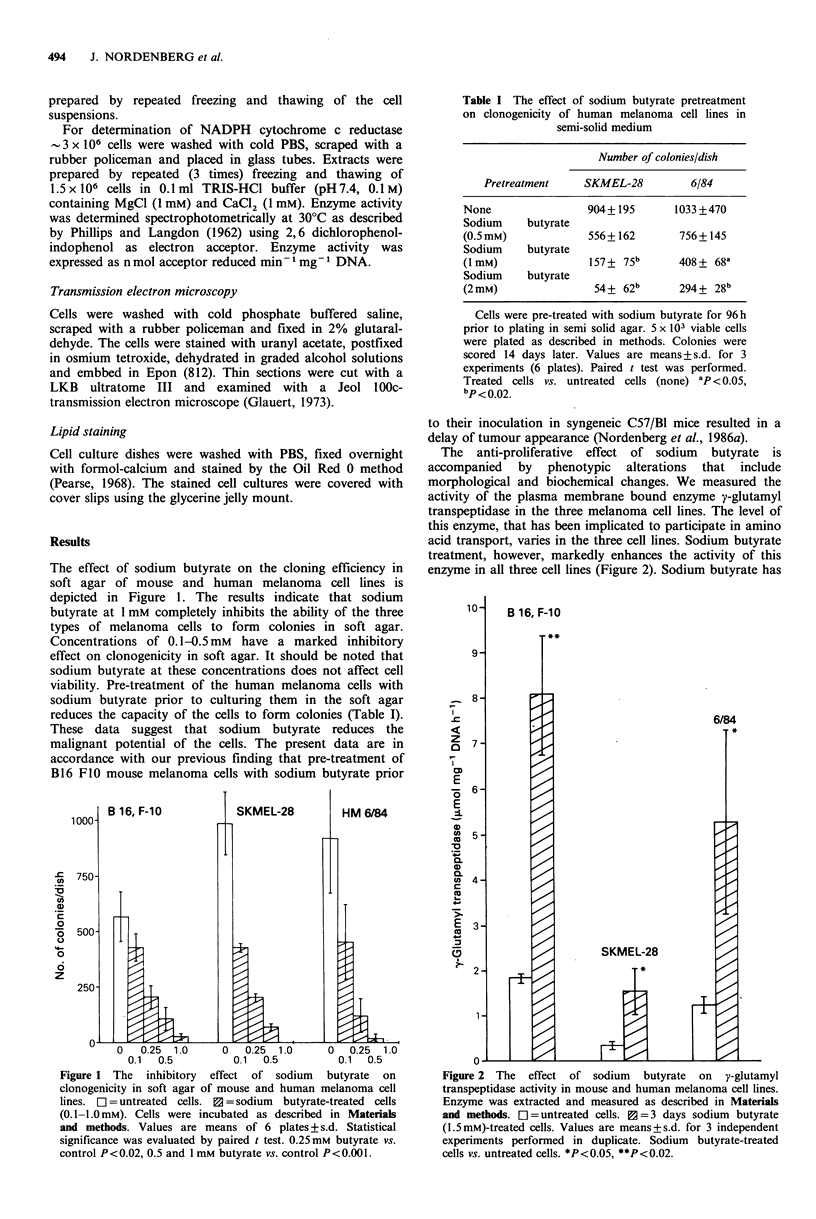
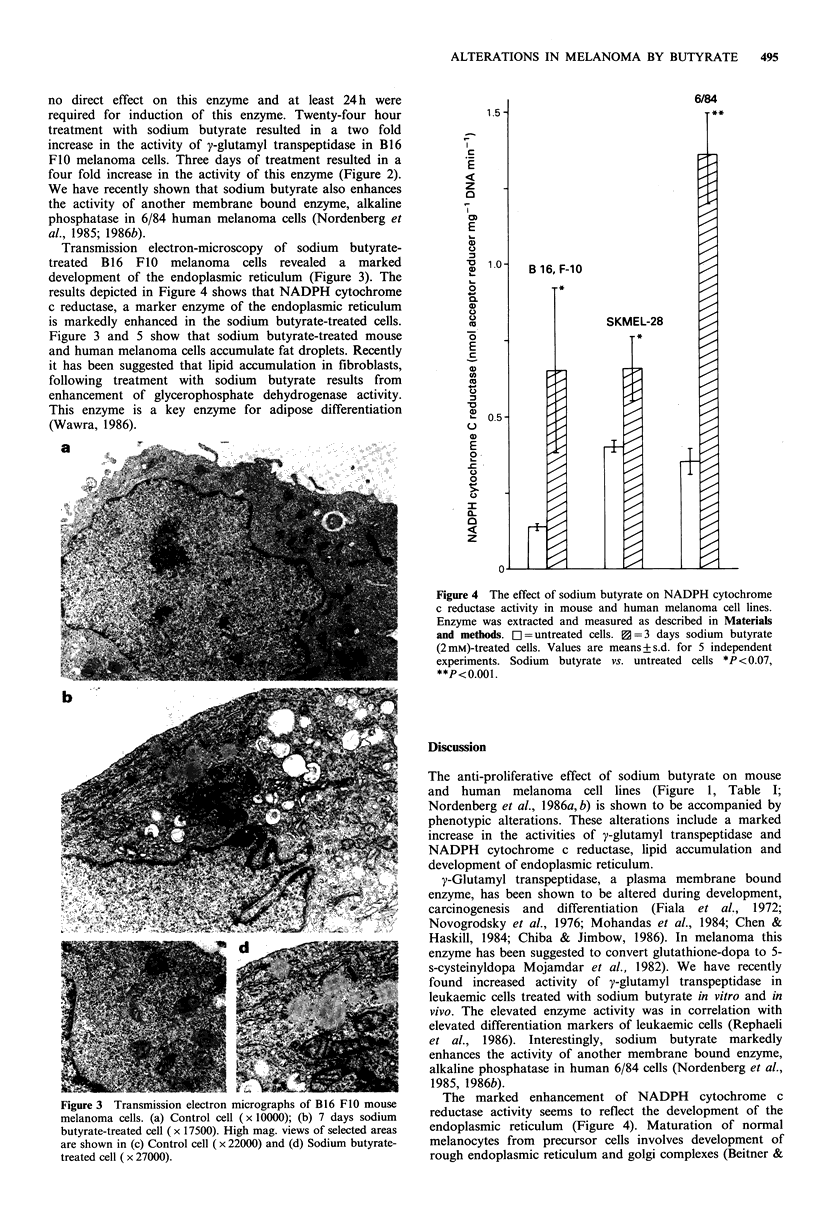
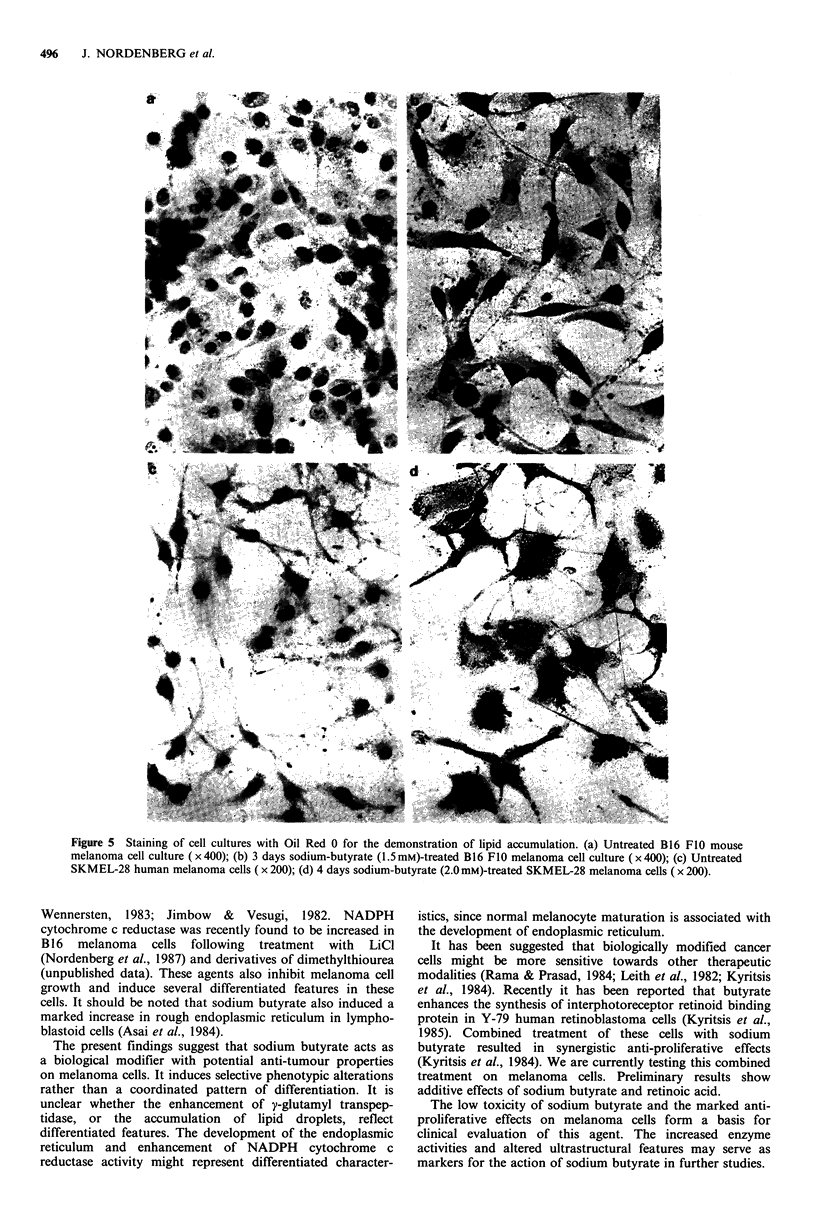

Images in this article
Selected References
These references are in PubMed. This may not be the complete list of references from this article.
- Abe M., Kufe D. W. Effect of sodium butyrate on human breast carcinoma (MCF-7) cellular proliferation, morphology, and CEA production. Breast Cancer Res Treat. 1984;4(4):269–274. doi: 10.1007/BF01806038. [DOI] [PubMed] [Google Scholar]
- Asai S., Namikawa I., Ito Y. Ultrastructural studies on human lymphoblastoid cells treated with n-butyrate and 12-O-tetradecanoylphorbol-13-acetate. Eur J Cancer Clin Oncol. 1984 Dec;20(12):1533–1542. doi: 10.1016/0277-5379(84)90147-0. [DOI] [PubMed] [Google Scholar]
- BURTON K. A study of the conditions and mechanism of the diphenylamine reaction for the colorimetric estimation of deoxyribonucleic acid. Biochem J. 1956 Feb;62(2):315–323. doi: 10.1042/bj0620315. [DOI] [PMC free article] [PubMed] [Google Scholar]
- Beitner H., Wennersten G. The immediate action of long-wave ultraviolet radiation (UVA) on suprabasal melanocytes in human skin: a transmission electron microscopical study. Acta Derm Venereol. 1983;63(4):328–334. [PubMed] [Google Scholar]
- Chen Y. F., Haskill S. Characterization of gamma-glutamyltranspeptidase in murine cervical cancer by biochemical and immunological techniques. Cancer Res. 1984 Oct;44(10):4548–4552. [PubMed] [Google Scholar]
- Chiba M., Jimbow K. Expression of gamma-glutamyl transpeptidase in normal and neoplastic epithelial cells of human skin: a marker for distinguishing malignant epithelial tumours. Br J Dermatol. 1986 Apr;114(4):459–464. doi: 10.1111/j.1365-2133.1986.tb02850.x. [DOI] [PubMed] [Google Scholar]
- Dexter D. L., Crabtree G. W., Stoeckler J. D., Savarese T. M., Ghoda L. Y., Rogler-Brown T. L., Parks R. E., Jr, Calabresi P. N,N-dimethylformamide and sodium butyrate modulation of the activities of purine-metabolizing enzymes in cultured human colon carcinoma cells. Cancer Res. 1981 Mar;41(3):808–812. [PubMed] [Google Scholar]
- Eliason J. F., Fekete A., Odartchenko N. Improving techniques for clonogenic assays. Recent Results Cancer Res. 1984;94:267–275. doi: 10.1007/978-3-642-82295-7_29. [DOI] [PubMed] [Google Scholar]
- Fiala S., Fiala A. E., Dixon B. -Glutamyl transpeptidase in transplantable, chemically induced rat hepatomas and "spontaneous" mouse hepatomas. J Natl Cancer Inst. 1972 May;48(5):1393–1401. [PubMed] [Google Scholar]
- Fishman P. H., Atikkan E. E. Induction of cholera toxin receptors in cultured cells by butyric acid. J Biol Chem. 1979 Jun 10;254(11):4342–4344. [PubMed] [Google Scholar]
- Fishman P. H., Simmons J. L., Brady R. O., Freese E. Induction of glycolipid biosynthesis by sodium butyrate in HeLa cells. Biochem Biophys Res Commun. 1974 Jul 10;59(1):292–299. doi: 10.1016/s0006-291x(74)80205-6. [DOI] [PubMed] [Google Scholar]
- Ghosh M. K., Cox R. P. Production of human chorionic gonadotropin in HeLa cell cultures. Nature. 1976 Feb 5;259(5542):416–417. doi: 10.1038/259416a0. [DOI] [PubMed] [Google Scholar]
- Hamburger A. W., Salmon S. E. Primary bioassay of human tumor stem cells. Science. 1977 Jul 29;197(4302):461–463. doi: 10.1126/science.560061. [DOI] [PubMed] [Google Scholar]
- Herz F., Halwer M. Synergistic induction of alkaline phosphatase in colonic carcinoma cells by sodium butyrate and hyperosmolality. Biochim Biophys Acta. 1982 Oct 8;718(2):220–223. doi: 10.1016/0304-4165(82)90222-7. [DOI] [PubMed] [Google Scholar]
- Jahangeer S., Elliott R. M., Henneberry R. C. beta-Adrenergic receptor induction in HeLa cells: synergistic effect of 5-azacytidine and butyrate. Biochem Biophys Res Commun. 1982 Oct 29;108(4):1434–1440. doi: 10.1016/s0006-291x(82)80067-3. [DOI] [PubMed] [Google Scholar]
- Jimbow K., Uesugi T. New melanogenesis and photobiological processes in activation and proliferation of precursor melanocytes after UV-exposure: ultrastructural differentiation of precursor melanocytes from Langerhans cells. J Invest Dermatol. 1982 Feb;78(2):108–115. doi: 10.1111/1523-1747.ep12505758. [DOI] [PubMed] [Google Scholar]
- Kim Y. S., Tsao D., Siddiqui B., Whitehead J. S., Arnstein P., Bennett J., Hicks J. Effects of sodium butyrate and dimethylsulfoxide on biochemical properties of human colon cancer cells. Cancer. 1980 Mar 15;45(5 Suppl):1185–1192. doi: 10.1002/1097-0142(19800315)45:5+<1185::aid-cncr2820451324>3.0.co;2-w. [DOI] [PubMed] [Google Scholar]
- Kyritsis A. P., Wiggert B., Lee L., Chader G. J. Butyrate enhances the synthesis of interphotoreceptor retinoid-binding protein (IRBP) by Y-79 human retinoblastoma cells. J Cell Physiol. 1985 Aug;124(2):233–239. doi: 10.1002/jcp.1041240210. [DOI] [PubMed] [Google Scholar]
- Kyritsis A., Joseph G., Chader G. J. Effects of butyrate, retinol, and retinoic acid on human Y-79 retinoblastoma cells growing in monolayer cultures. J Natl Cancer Inst. 1984 Sep;73(3):649–654. [PubMed] [Google Scholar]
- Leavitt J., Barrett J. C., Crawford B. D., Ts'o P. O. Butyric acid suppression of the in vitro neoplastic state of Syrian hamster cells. Nature. 1978 Jan 19;271(5642):262–265. doi: 10.1038/271262a0. [DOI] [PubMed] [Google Scholar]
- Leder A., Leder P. Butyric acid, a potent inducer of erythroid differentiation in cultured erythroleukemic cells. Cell. 1975 Jul;5(3):319–322. doi: 10.1016/0092-8674(75)90107-5. [DOI] [PubMed] [Google Scholar]
- Leith J. T., Gaskins L. A., Dexter D. L., Calabresi P., Glicksman A. S. Alteration of the survival response of two human colon carcinoma subpopulations to x-irradiation by N,N-dimethylformamide. Cancer Res. 1982 Jan;42(1):30–34. [PubMed] [Google Scholar]
- Mohandas J., Marshall J. J., Duggin G. G., Horvath J. S., Tiller D. J. Low activities of glutathione-related enzymes as factors in the genesis of urinary bladder cancer. Cancer Res. 1984 Nov;44(11):5086–5091. [PubMed] [Google Scholar]
- Mojamdar M., Ichihashi M., Mishima Y. Tyrosinase and gamma-glutamyl transpeptidase in 5-s-cysteinyldopa genesis within melanotic and amelanotic melanomas. J Dermatol. 1982 Feb;9(1):73–77. doi: 10.1111/j.1346-8138.1982.tb02605.x. [DOI] [PubMed] [Google Scholar]
- Novogrodsky A., Tate S. S., Meister A. gamma-Glutamyl transpeptidase, a lymphoid cell-surface marker: relationship to blastogenesis, differentiation, and neoplasia. Proc Natl Acad Sci U S A. 1976 Jul;73(7):2414–2418. doi: 10.1073/pnas.73.7.2414. [DOI] [PMC free article] [PubMed] [Google Scholar]
- PHILLIPS A. H., LANGDON R. G. Hepatic triphosphopyridine nucleotide-cytochrome c reductase: isolation, characterization, and kinetic studies. J Biol Chem. 1962 Aug;237:2652–2660. [PubMed] [Google Scholar]
- Prager M. D., Kanar M. C. Effect of dimethylsulfoxide and butyrate on 5'-nucleotidase of human renal carcinoma cells. Cancer Lett. 1984 Aug;24(1):81–88. doi: 10.1016/0304-3835(84)90083-1. [DOI] [PubMed] [Google Scholar]
- Prasad K. N. Butyric acid: a small fatty acid with diverse biological functions. Life Sci. 1980 Oct 13;27(15):1351–1358. doi: 10.1016/0024-3205(80)90397-5. [DOI] [PubMed] [Google Scholar]
- Prasad K. N. Effect of sodium butyrate in combination with X-irradiation, chemotherapeutic and cyclic AMP stimulating agents on neuroblastoma cells in culture. Experientia. 1979 Jul 15;35(7):906–908. doi: 10.1007/BF01955141. [DOI] [PubMed] [Google Scholar]
- Rama B. N., Prasad K. N. Effects of dl-alpha-tocopheryl succinate in combination with sodium butyrate and cAMP stimulating agent on neuroblastoma cells in culture. Int J Cancer. 1984 Dec 15;34(6):863–867. doi: 10.1002/ijc.2910340619. [DOI] [PubMed] [Google Scholar]
- Reeves R., Cserjesi P. Sodium butyrate induces new gene expression in Friend erythroleukemic cells. J Biol Chem. 1979 May 25;254(10):4283–4290. [PubMed] [Google Scholar]
- Rubenstein P., Sealy L., Marshall S., Chalkley R. Cellular protein synthesis and inhibition of cell division are independent of butyrate-induced histone hyperacetylation. Nature. 1979 Aug 23;280(5724):692–693. doi: 10.1038/280692a0. [DOI] [PubMed] [Google Scholar]
- Sealy L., Chalkley R. The effect of sodium butyrate on histone modification. Cell. 1978 May;14(1):115–121. doi: 10.1016/0092-8674(78)90306-9. [DOI] [PubMed] [Google Scholar]
- Simmons J. L., Fishman P. H., Freese E., Brady R. O. Morphological alterations and ganglioside sialyltransferase activity induced by small fatty acids in HeLa cells. J Cell Biol. 1975 Aug;66(2):414–424. doi: 10.1083/jcb.66.2.414. [DOI] [PMC free article] [PubMed] [Google Scholar]
- Stevens M. S., Aliabadi Z., Moore M. R. Associated effects of sodium butyrate on histone acetylation and estrogen receptor in the human breast cancer cell line MCF-7. Biochem Biophys Res Commun. 1984 Feb 29;119(1):132–138. doi: 10.1016/0006-291x(84)91628-0. [DOI] [PubMed] [Google Scholar]
- Tate S. S., Meister A. Interaction of gamma-glutamyl transpeptidase with amino acids, dipeptides, and derivatives and analogs of glutathione. J Biol Chem. 1974 Dec 10;249(23):7593–7602. [PubMed] [Google Scholar]
- Wawra E. Longterm effects of sodium butyrate on mouse fibroblasts: a model for differentiation? Cell Mol Biol. 1986;32(2):121–129. [PubMed] [Google Scholar]
- Wright J. A. Morphology and growth rate changes in Chinese hamster cells cultured in presence of sodium butyrate. Exp Cell Res. 1973 Apr;78(2):456–460. doi: 10.1016/0014-4827(73)90091-8. [DOI] [PubMed] [Google Scholar]



